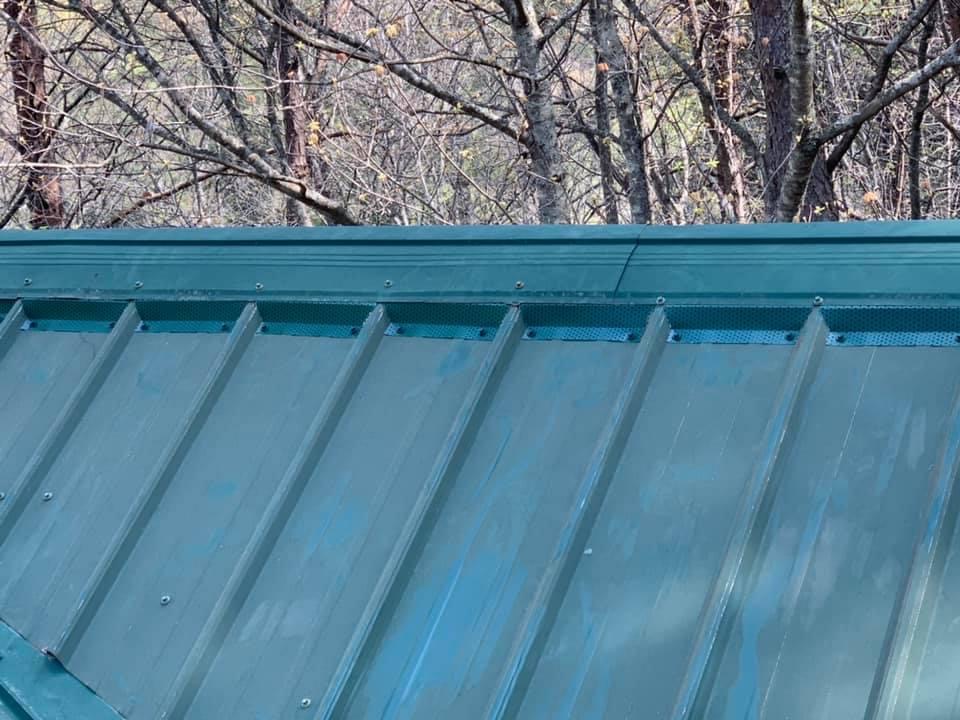
Metal roofs may not offer the protection you think they do when it comes to rodent-proofing your home. Despite their strength and durability, metal roofing systems often have built-in vulnerabilities that make it easier for rodents to gain access to your attic or walls.
In this post, we’ll break down exactly why metal roofs are more prone to wildlife entry, where the weak points are, and how Elite Wildlife Solutions provides a permanent, professional-grade seal that keeps your home safe.
The Ridge Vent Problem
Most metal roofs feature ridge vents that lack proper screening underneath. This design flaw allows rodents and other wildlife direct access into your attic or even into vaulted ceilings, which—contrary to what many believe—absolutely provide enough space for rodents to nest.
Here’s why that’s a big problem:
- Rodents and bats can follow the seams right up to the ridge
- They squeeze through open slots under the ridge cap
- Attics and even vaulted ceilings provide ample space for nesting
Many companies try to apply a “spot seal” solution — closing off a few visible areas. But ridge vents are a continuous system, so missing even one small gap makes the entire seal ineffective.
Why Mesh Isn’t Enough to Stop Rodents
One of the most common mistakes in the wildlife removal industry is using mesh to seal roof gaps. While it may stop animals from getting through, mesh doesn’t prevent something just as dangerous: contamination.
Rodents, bats, and squirrels leave behind:
- Urine and feces
- Bat guano
- Nesting materials and food waste
- Bacteria and airborne pathogens
Mesh allows these contaminants to fall through into your attic, causing strong odors, health hazards, and costly insulation damage.
The “Tuck and Stuff” Problem
Some companies cut mesh pieces and “stuff” them into ridge seams using caulk or foam as support. This approach fails for several reasons:
- Foam and caulk degrade quickly in weather exposure
- They often block airflow, creating ventilation problems
- When rushed, technicians cut mesh too short, creating gaps
Moisture buildup can lead to mold, mildew, and rot in your attic
Hidden Rodent Entry in Metal Roof Returns
Another weak point in metal roofs is at the returns, where metal braces are often left out during installation, leaving weak points that may appear sealed but actually flex under pressure.
If pressing on the return feels like a “doggy door,” you’ve got a hidden rodent entry point.
In fact, we find these soft spots in 9 out of 10 metal roof inspections.
How Elite Wildlife Solutions Seals Metal Roofs the Right Way
We don’t patch. We engineer permanent solutions that protect both your home and its ventilation system.
For Ridge Vents:
We offer two professional sealing methods, depending on the roof style and visibility:
- Hidden Ridge Barrier: Discreetly blocks all rodent access while allowing airflow.
- Custom-Fabricated Covers: Made from powder-coated steel, color-matched to your roof for a clean, factory-installed appearance.
Both methods maintain proper roof ventilation — a must in hot or humid climates — while delivering long-term exclusion results.
For Returns:
We install custom steel brackets to bind the soffit and roof seam tightly. This removes any flex and creates a rodent-proof barrier that blends into your existing structure.
Why It Matters
Rodent-proofing your roof isn’t just about blocking access—it’s about doing it the right way. Cheap mesh and foam fixes may work short-term, but they almost always lead to re-entry, contamination, and ventilation issues.
With Elite Wildlife Solutions, you’re getting a permanent, professional-grade seal using the best materials in the industry. Our solutions are engineered to protect your home, preserve your roof’s ventilation, and ensure long-term peace of mind.
Don’t fall for the budget fix. Choose quality. Choose Elite.
FAQs About Rodents in Metal Roofs
Q: Are metal roofs more vulnerable to rodents?
Yes — metal roofs often have open ridge vents and unbraced returns that create entry points for rodents, bats, and squirrels.
Q: Does mesh work to seal a roof against wildlife?
Not fully. While mesh blocks animals, it doesn’t stop urine, droppings, or airborne pathogens from entering your home.
Q: What’s the best way to seal a metal roof from rodents?
Custom-fabricated, powder-coated steel barriers that maintain airflow while closing off entry points — like the solutions used by Elite Wildlife Solutions.
